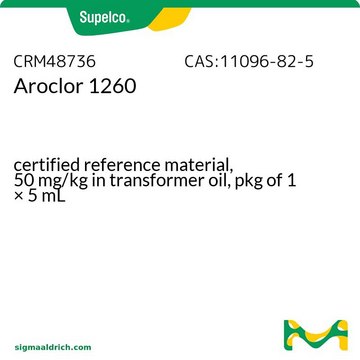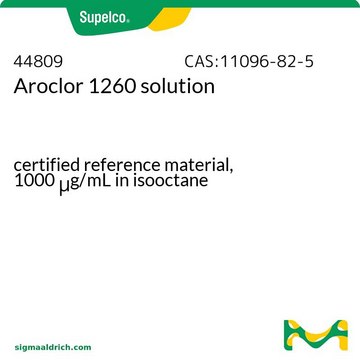48735
Aroclor 1260 solution
certified reference material, 500 mg/kg in transformer oil
About This Item
Produtos recomendados
grau
certified reference material
TraceCERT®
Nível de qualidade
linha de produto
TraceCERT®
Certificado de análise (CofA)
current certificate can be downloaded
embalagem
ampule of 5 mL
concentração
500 mg/kg in transformer oil
técnica(s)
HPLC: suitable
gas chromatography (GC): suitable
aplicação(ões)
environmental
Formato
single component solution
temperatura de armazenamento
2-30°C
cadeia de caracteres SMILES
Clc1c(c(ccc1Cl)c2c(c(c(cc2)Cl)Cl)Cl)Cl
InChI
1S/C12H4Cl6/c13-7-3-1-5(9(15)11(7)17)6-2-4-8(14)12(18)10(6)16/h1-4H
chave InChI
BTAGRXWGMYTPBY-UHFFFAOYSA-N
Procurando produtos similares? Visita Guia de comparação de produtos
Categorias relacionadas
Aplicação
Outras notas
Informações legais
Palavra indicadora
Danger
Frases de perigo
Declarações de precaução
Classificações de perigo
Aquatic Chronic 3 - Carc. 1B - STOT RE 2
Código de classe de armazenamento
6.1C - Combustible acute toxic Cat.3 / toxic compounds or compounds which causing chronic effects
Classe de risco de água (WGK)
WGK 3
Ponto de fulgor (°F)
Not applicable
Ponto de fulgor (°C)
Not applicable
Equipamento de proteção individual
Eyeshields, Gloves, type ABEK (EN14387) respirator filter
Escolha uma das versões mais recentes:
Certificados de análise (COA)
It looks like we've run into a problem, but you can still download Certificates of Analysis from our Documentos section.
Se precisar de ajuda, entre em contato Atendimento ao cliente
Já possui este produto?
Encontre a documentação dos produtos que você adquiriu recentemente na biblioteca de documentos.
Nossa equipe de cientistas tem experiência em todas as áreas de pesquisa, incluindo Life Sciences, ciência de materiais, síntese química, cromatografia, química analítica e muitas outras.
Entre em contato com a assistência técnica








